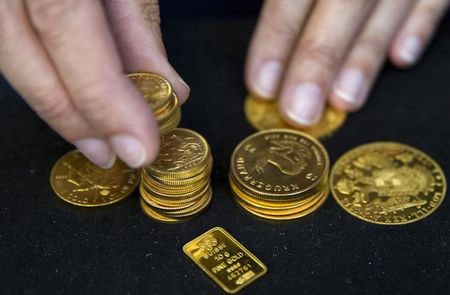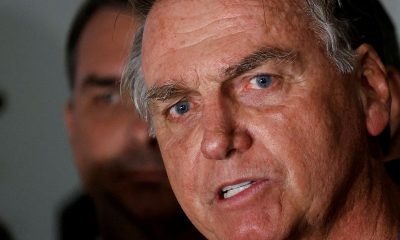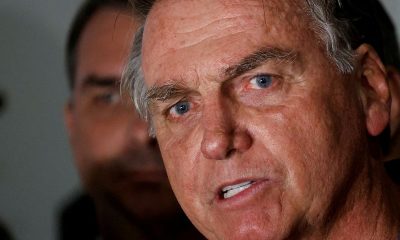Commodities
This central bank is likely to remain a major buyer in the gold market

Investing.com — ’s rise this year has surpassed other commodities such as and , distinguishing it in global markets.
The rise in gold prices has been driven in part by central bank purchases, which have become a significant factor in recent years.
As per analysts at BCA Research in a note dated Friday, central banks, especially those in emerging markets, have expanded their gold reserves, and this trend is expected to continue.
These purchases have contributed to sustained demand for gold, supporting the potential for further price increases in the near future.
In recent years, central banks have become one of the most important drivers of gold demand. “Central bank purchases in the first half of this year reached the highest first half year on records dating back to 2000,” the analysts said.
Over the past two years, central banks have accounted for around a quarter of global gold demand—more than double the 11% average of the previous five years. Emerging market central banks have led this charge, increasing their reserves of the precious metal for a variety of strategic reasons.
The reasons behind central bank gold purchases are linked to several key factors. Gold’s value is supported by its limited supply, which differs from fiat currencies that can be subject to inflation or devaluation due to increases in money supply.
As a result, gold serves as a hedge against inflation and currency devaluation, which are important considerations for central banks.
Additionally, gold does not carry credit or counterparty risk, providing central banks with a safeguard against economic instability or financial disruptions.
Furthermore, gold’s tendency to move inversely to the U.S. dollar offers a means of diversifying reserve portfolios, helping to protect reserves during periods of dollar weakness.
Geopolitical considerations have further fueled the push toward gold.
“The West’s response to Russia’s invasion of Ukraine ultimately underscores the vulnerability of holding reserves in traditional currencies,” the analysts said.
Sanctions against Russia resulted in the freezing of its foreign reserves, prompting other countries to consider the security of their own reserves.
Gold, being a tangible asset that central banks can fully control, provides protection from such risks.
According to the World Gold Council’s latest Central Bank Gold Reserves Survey, the outlook for continued central bank demand is robust.
The survey found that 81% of central banks expect global gold reserves to increase over the coming year, the highest percentage in the survey’s six-year history.
This sentiment is not just global; 29% of central banks specifically expect their own gold reserves to rise, signaling a strong commitment to further accumulation.
One of the central players in this wave of gold purchases is the People’s Bank of China (PBoC). Since 2022, the PBoC has increased its gold reserves by an impressive 316 metric tons, an average of 11 tons per month.
However, in recent months (May to July 2023), the PBoC has reported no new purchases, raising questions about whether rising gold prices have caused a temporary pause in their buying.
BCA Research analysts believe that while the PBoC may be sensitive to short-term price fluctuations, its long-term strategy to diversify away from U.S. dollar-denominated assets will remain the dominant factor.
Gold plays a crucial role in China’s effort to reduce its reliance on the dollar, and this strategic imperative is likely to sustain future purchases, regardless of near-term price trends.
Historically, the PBoC has been known for its opacity regarding gold purchases, often disclosing large increases only after years of accumulation. For instance, in 2015, China revealed that it had increased its gold reserves by 60% over the previous six years, during which no purchases had been reported.
Despite its recent gold-buying spree, gold still makes up only 4.9% of China’s total reserves, compared to an average of 15% for other upper-middle-income economies. This leaves substantial room for further accumulation.
If the PBoC were to increase the share of gold in its reserves to 15% over the next decade, it would need to purchase roughly 120 tons of gold per quarter, which would account for 11% of global annual gold demand at current levels. Such an increase would have an impact on the gold market, boosting prices further.
China is not alone in its enthusiasm for gold. Other emerging market central banks have also significantly boosted their gold holdings in recent years. Poland, for instance, has explicitly set a goal to increase gold’s share of its reserves from 13.5% to 20% in the coming years.
The Polish central bank has already bought 149 metric tons of gold since the second quarter of 2023, and further purchases are expected. This aligns with a broader trend among EM central banks to diversify their reserves and reduce their exposure to the U.S. dollar.
Similarly, the Reserve Bank of India has been steadily increasing its gold reserves as part of a strategy to diversify its assets. The RBI has also repatriated a significant portion of its gold reserves from foreign vaults, transferring 100 tons from the UK to India earlier this year.
Nigeria has taken similar steps, repatriating its gold from the U.S. to domestic storage. These moves reflect a growing desire among EM central banks to safeguard their gold reserves and shield them from potential geopolitical risks.
The broader strategic trend of EM central banks increasing their gold holdings is clear. Gold provides these countries with a secure store of value, free from the potential risks associated with holding reserves in foreign currencies, particularly the U.S. dollar.
The geopolitical climate and recent global events have reinforced the importance of this diversification strategy.
In addition to this the current economic outlook is also supportive of gold. As per BCA Research, a global economic downturn is projected by late 2024 or early 2025, a period during which gold has typically performed well.
During times of below-trend economic activity, central banks often increase their gold purchases as a precautionary measure. As a result, the potential for an economic slowdown in the coming year is likely to sustain strong demand from central banks.
In addition to central bank demand, real interest rates are a key factor influencing gold prices. As U.S. real interest rates decline, the opportunity cost of holding gold decreases, making it a more attractive investment.
“Real interest rates will likely downshift as the Fed will probably start the easing cycle at the September 17-18 FOMC meeting,” the analysts said, which would further incentivize both institutional and central bank gold purchases.
Indeed, global gold ETFs have already seen four consecutive months of inflows, reversing nearly a year of outflows and signaling renewed interest from investors.
Commodities
Oil prices rise; U.S. crude inventories plunge, Russia-Ukraine truce eyed
Commodities
India’s Reliance to stop buying Venezuelan oil over US tariffs, sources say
Commodities
Oil prices climb on Venezuela supply worries

 Forex3 years ago
Forex3 years agoForex Today: the dollar is gaining strength amid gloomy sentiment at the start of the Fed’s week

 Forex3 years ago
Forex3 years agoUnbiased review of Pocket Option broker

 Forex3 years ago
Forex3 years agoDollar to pound sterling exchange rate today: Pound plummeted to its lowest since 1985

 Forex3 years ago
Forex3 years agoHow is the Australian dollar doing today?

 Cryptocurrency3 years ago
Cryptocurrency3 years agoWhat happened in the crypto market – current events today

 World3 years ago
World3 years agoWhy are modern video games an art form?

 Commodities3 years ago
Commodities3 years agoCopper continues to fall in price on expectations of lower demand in China

 Economy3 years ago
Economy3 years agoCrude oil tankers double in price due to EU anti-Russian sanctions



























